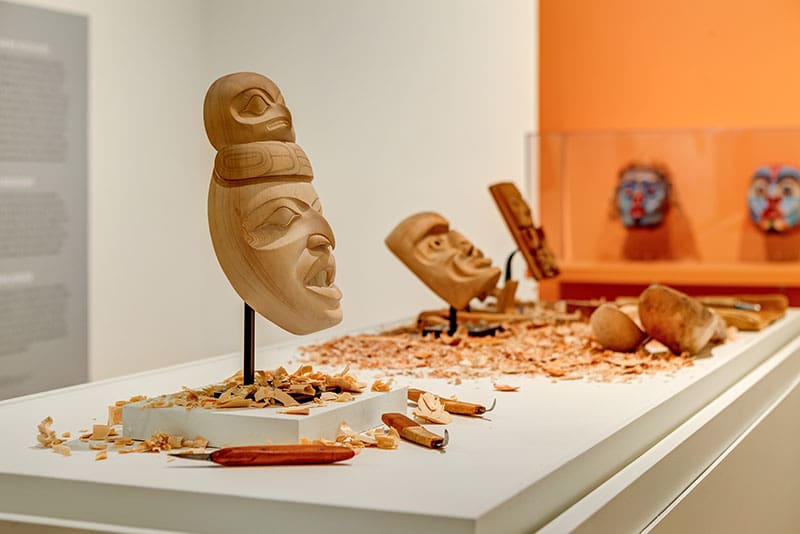Curve!
Women Carvers on the Northwest Coast
Story by Katherine Fawcett
Installation Views Photos Joern Rohde - Curve! Women Carvers on the Northwest Coast



Marika Echachis Swan was raised in a community of carvers: mask, pole, and canoe carvers. “I grew up around wood chips, sharp knives and the smell of cedar, but I also grew up around carvers that were all men.” Luckily, the men in Swan’s life supported her in discovering her own carving skills despite it being a male-dominated art form and activity.
“My dad and his blood and chosen brothers always encouraged me to carve with them. My favourite times when I think of spending time with them were when we spent time in the shop, chipping away on projects. Slowly but surely; slowly but surely.”
Swan, a Nuu-cha-nulth artist, spoke at the opening of the Audain Art Museum’s (AAM) current exhibition Curve! Women Carvers on the Northwest Coast. The historic exhibition brings together 127 artistic works, on loan from public and private collections, from 14 Indigenous women carvers from the Northwest Coast, focusing on carvers active from the 1950s to the present day.
The exhibit is the first-ever gathering of female carvers and spans eight decades of artistry. Some pieces strictly adhere to traditions of ancestral styles, while others are contemporary personal creations. However, all are powerful visions by First Nations women’s hands that bring land, wisdom, story and femininity to life.

“Carving is about understanding the woods and grains and how they move,” said Swan. “Carving is about understanding shape, and how each curve meets the next to create a seamless flow, a face and shape and creature and story.”
Nearly half of the pieces on display are masks, which are often used in rituals at dances and potlatch ceremonies. Masks transform wearers into embodiments of supernatural beings, animals, or ancestral spirits. One shows a woman who is part human, part shark. Another depicts an eagle-human cross, with a long, curved, beak-ish nose, while another features a woman with salmon entwined in her hair.
“They predominantly represent female faces,” said Dr. Curtis Collins, the museum’s director and chief curator. “The carving tradition in this exhibit is women representing women.” Collins worked in tandem with Dana Claxton, Hunkpapa Lakota filmmaker, photographer, performance artist and co-curator, for more than two years to bring the exhibition to light.
Visitors will also see totems, panels, bowls, paddles, and other sculptures. Works are made of yellow cedar, red cedar, alder, ash, birch, and argillite, the latter a dense black rock found in Haida Gwaii. Several include elements of hair, leather, bone, antler, shell, copper, or stained glass.
Each work represents days — months, even years — of physical, creative and emotional labour. “Carving is actually extremely hard work,” Swan said. “It requires an extraordinary amount of patience and perseverance.” She said that for every piece of art that manages to flow back into itself in a way that a carving should, there will be “many, many awfully shaped things.”
Swan conducted extensive interviews with the participating Curve! artists for panels placed alongside their work. She was moved to discover many commonalities among the women. “Creating beautiful things is only a small part of who we are,” she said. “The beauty is only a reflection of the care and the respect we have for our inheritance, our culture, and our values.”

Cori Savard, Xiilang (Thunderbird), 2021
Yellow cedar, pigment
91 x 91 x 5 cm
Private Collection | Photo: Kenji Nagai

Arlene Ness, Bone Pendant, 2021
Bone, gold
12.25 x 4 x 1.5 cm
Private Collection | Photo: Kenji Nagai

Ellen Neel, Totemland, c. 1965
Wood, pigment
57.15 x 34.29 x 15.24 cm
Private Collection | Photo: Kenji Nagai

Dale Marie Campbell, Woman Who Brought the Salmon, 2021
Alder, abalone shell, pigment
33 × 30 × 10 cm
Private Collection | Photo: NK Photo
An ancient Indigenous tradition on the Northwest Coast, carving can be traced back at least 5,000 years. Despite government policies and the residential school system that attempted to wipe out the practice (along with the language, culture and identity of First Nations people), carving was revitalized in the mid-1900s. However, Indigenous women carvers were often overlooked, as they were traditionally pegged as bead-workers, painters and weavers. Artists such as the late Ellen Neel, Freda Diesing, and Doreen Jensen burst through those stereotypes and paved the way for younger generations of carvers. As co-curators, Collins and Claxton worked tirelessly to spotlight these pioneering artists and the legacy of women carvers following in their footsteps.
“Supporting Native women is supporting the backbones of our communities,” Swan said. “Each of these objects carries with them not only the flesh and materials that were made from living trees and grandparent stones, but they also carry the intentions and teachings of the artists.”
The exhibition is accompanied by a stunning hard-cover book featuring texts and interviews with full-colour images of work by the 14 participating artists.
Curve! Women Carvers on the Northwest Coast runs at the Audain Art Museum until May 5, 2025.
audainartmuseum.com


